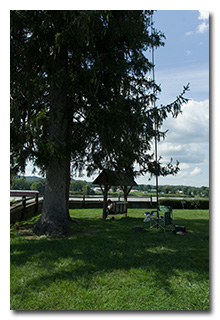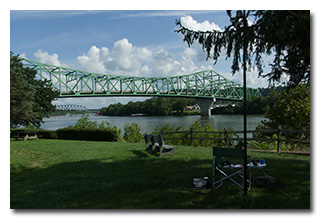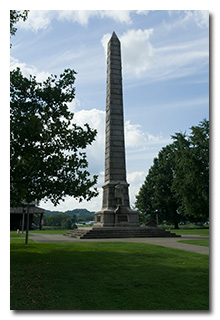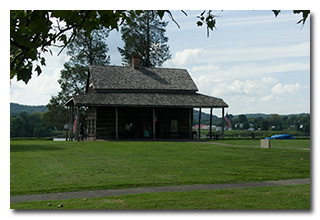
by William Eric McFadden
Skeeter Hunt RATpedition!
From the Tu-Endie-Wei State Park website:
-
At the junction of the Ohio and Kanawha Rivers, Tu-Endie-Wei stands as a monument to commemorate the frontiersmen who fought and died at the Battle of Point Pleasant. On October 10, 1774, Colonel Andrew Lewis' 1,100 Virginia militiamen decisively defeated a like number of Native Americans lead by the Shawnee Chieftain Cornstalk in a bloody, day-long battle. At the end, 230 Native Americans were killed or wounded and more than 50 Virginians had lost their lives, including Colonel Charles Lewis, brother of the commanding officer. Considered a landmark in frontier history, some believed the battle to be the first of the American Revolution. This action broke the power of the ancient Americans in the Ohio Valley and quelled a general war on the frontier. Significantly, it also prevented an alliance between the British and Native Americans, one which could very possibly have caused the Revolution to have a different outcome, altering the entire history of the nation. In addition, the ensuing peace with the Native Americans enabled western Virginians to return across the Allegheny Mountains to aid Revolutionary forces. The battle is recognized as the decisive engagement in a proactive series of Indian wars. The monument derives its name "Tu-Endie-Wei" from a Wyandotte word meaning "point between two waters."
From the Lewis and Clark National Historic Trail website:
-
The Lewis and Clark National Historic Trail is approximately 4,900 miles long, extending from Pittsburgh, Pennsylvania, to the mouth of the Columbia River, near present day Astoria, Oregon. It follows the historic outbound and inbound routes of the Lewis and Clark Expedition as well as the preparatory section from Pittsburgh, Pennsylvania to Wood River, Illinois.
Pictures
On Sunday, August 27, 2023, one member of the Southeast Ohio Radio Adventure Team performed successful simultaneous activations of Tu-Endie-Wei State Park (K-1994) and Lewis and Clark National Historic Trail (K-4572) as part of the Parks on the Air (POTA; link) program.
Eric McFadden, WD8RIF, performed his activations of Tu-Endie-Wei State Park and Lewis and Clark National Historic Trail while participating in the New Jersey QRP Club's Skeeter Hunt (link) field operating event as Skeeter #121. Eric was accompanied by his wife Vickie and their small dogs Theo and Ginny.
Eric, Vickie, and the dogs arrived at Tu-Endie-Wei State Park at around 1820 UTC. Eric walked Theo, greeted the volunteer working in the Mansion House museum and explained his plans to her, and scouted out a location to set up his station at the very small park. Wanting a bit of shade, Eric chose to set up his station beneath the majestic pine at the very corner of the park, overlooking the confluence of the two mighty rivers, strapping his 31' Jackite telescoping fiberglass pole to his folding camp-chair, deploying his 28½' speaker-wire vertical on the Jackite pole and laying three 17' counterpoise wires on the ground, and placing his Elecraft KX3 on the camp-chair's fold-up table. Eric was on the air at 1843 UTC, nearly two hours into the Skeeter Hunt's four-hour period.
Tu-Endie-Wei State Park being right within the city of Point Pleasant, West Virginia, Eric had good cell-signal at his operating location and he would be able to spot himself initially to QRPSpots (link), and later to POTA Spots (link).
Finding unexpected S5 power-line noise on 40m, Eric chose to start his operating on 20m. While looking for a clear frequency, at 1844 UTC he found and worked KD0V, Skeeter #112, in Minnesota. After finding a clear frequency to run near the international 20m QRP CW calling frequency, Eric spotted himself to QRPSpots as encouraged by the Skeeter Hunt organizer and his first QSO in this run came at 1847 UTC with NN5DE in Texas. QSOs came steadily, with Eric's ninth QSO in this run coming at 1914 UTC with AA5AD in Arkansas. All nine of these QSOs were with operators participating in Skeeter Hunt, and all the exchanges included either a Skeeter Number or QRP-level power output.
After the QSO with AA5AD, Eric stayed on 20m but spotted himself to POTA Spots and his first QSO in this run came at 1916 UTC with VE3EDX in Ontario. QSOs came steadily, with Eric's sixth QSO in this run coming at 1923 UTC with W4RNO in Florida. This run included QSOs with three operators participating in Skeeter Hunt and three QSOs with POTA hunters.
Switching to 40m, Eric engaged the KX3's Noise Reduction feature to help with the S5 noise on that band, found a clear frequency near the international QRP CW calling frequency, and began calling "CQ QRP",not bothering to update his spot on QRPSpots or POTA Spots. His first QSO in this run came at 1929 UTC with AB9CA in Indiana. QSOs came steadily, with Eric's twenty-second QSO in this run coming at 1958 UTC with K4MI in Virginia. This run included QSOs with seven operators participating in Skeeter Hunt and fifteen QSOs with POTA hunters.
In all, Eric logged thirty-seven QSOs, after removing one dupe, in about seventy-five minutes of on-air time. All of Eric's QSOs were CW and were made with five watts output. Eric had chosen to use his Elecraft KX3 for this operation specifically to qualify for the Skeeter Hunt multiplier (x4) for "portable station - home brewed or kit built transceiver or separates".
WD8RIF Skeeter Hunt Log: Band Mode Date Time Call RST (s) RST (r) SPC Exchange 20m CW 8/27/2023 1844 KD0V 559 559 MN #112 20m CW 8/27/2023 1847 NN5DE 539 559 TX #188 20m CW 8/27/2023 1848 KD5FCF 579 579 OK 4w 20m CW 8/27/2023 1851 N0EVH 599 559 MO #77 20m CW 8/27/2023 1854 K6MW 539 599 WA #51 20m CW 8/27/2023 1900 WD9GKZ 229 449 FL 4w 20m CW 8/27/2023 1905 N5GW 599 599 MS #88 20m CW 8/27/2023 1908 W0TG 599 579 TX #3 20m CW 8/27/2023 1909 W4IFI 559 559 CO 5w 20m CW 8/27/2023 1914 AA5AD 579 579 AR #245 20m CW 8/27/2023 1916 VE3EDX 559 559 ON #137 20m CW 8/27/2023 1917 KF4GAA 599 559 FL 20m CW 8/27/2023 1918 W8TK 599 579 AZ 20m CW 8/27/2023 1919 K2WO 559 599 FL #80 20m CW 8/27/2023 1921 KG5IEE 539 559 TX #60 20m CW 8/27/2023 1923 W4RNO 599 559 FL 40m CW 8/27/2023 1929 AB9CA 579 559 IN #33 40m CW 8/27/2023 1930 WB8DTT 579 579 MI 40m CW 8/27/2023 1931 K4KBL 539 569 GA 5w 40m CW 8/27/2023 1932 N3MK 559 559 VA 40m CW 8/27/2023 1933 WR2E 539 559 NJ 40m CW 8/27/2023 1934 KA4RRU 559 599 VA 40m CW 8/27/2023 1935 W5GDW 559 569 NC #27 40m CW 8/27/2023 1936 WD4AWD 579 559 TN 40m CW 8/27/2023 1938 KC9LC 579 559 VA 40m CW 8/27/2023 1940 AC9K 339 559 VA 40m CW 8/27/2023 1941 W3TS 559 559 MO 5w 40m CW 8/27/2023 1942 WA4JK 559 559 AL 40m CW 8/27/2023 1944 K3VAT 559 599 VA 40m CW 8/27/2023 1946 N2TNN 229 559 VA #194 40m CW 8/27/2023 1948 KK4UG 559 599 VA 5w 40m CW 8/27/2023 1949 WD9DWX 229 559 IN 40m CW 8/27/2023 1951 KB3AAY 599 579 MD 40m CW 8/27/2023 1952 W3SI 539 559 MD #19 40m CW 8/27/2023 1954 WD8AGN 559 599 VA 40m CW 8/27/2023 1957 KJ4ASE 599 559 VA 40m CW 8/27/2023 1958 K4MI 599 599 MD
Skeeter Hunt Submission:
-
Eric - WD8RIF - WV
Skeeter #121 - All CW
Single Op
Skeeter QSOs - 14
Non-Skeeter QRP QSOs - 6
Non-Skeeter QRO QSOs - 17
S/P/Cs - 21
Station Class Multiplier - x4 (portable / homebrew)
Bonus: Palindrome Skeeters - 3
Eric also submitted his log to the World Wide Flora and Fauna in Amateur Radio (WWFF; link) program for an operation at Tu-Endie-Wei State Park, KFF-1823.
(return)
Attribution: Skeeter Hunt Logo copyright NJ QRP Club.








